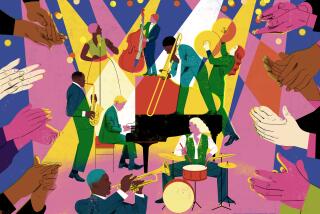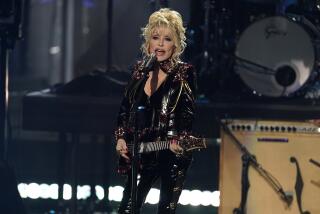JAZZ REVIEW : Alumni Have a Woodchopper’s Ball
- Share via
NEWPORT BEACH — For insatiable big-band gluttons, the four-day fiesta billed as “Early Autumn” was a visit to heaven.
Dozens of Woody Herman alumni paid tribute to the clarinetist-maestro, who died in 1987. Along with seven orchestral sessions held in an amphitheater at the Hyatt Newporter Hotel, small groups played amiable poolside lunch concerts. However, in a matinee by vibist Terry Gibbs’ Dream Band, the hot sun beating down on the jazzmen seemed to have a debilitating effect.
Not all the music was Herman-related. In fact, one atonal duet set--with Jimmy Giuffre on reeds and Paul Bley on piano--was light-years away from “Four Brothers,” the Giuffre tune that gave Herman’s second Herd its identity. For the most part, though, the performances recaptured the spirit of Herman’s bands in their various incarnations.
On the poignant “Early Autumn,” Gibbs recapped his original vibes solo and Bill Perkins played the part of the late saxman Stan Getz. Perkins also offered a set of his own that included a wildly upbeat version of “Tenderly.”
Bill Holman is a writer whose arrangements see around corners. His “Hommage a Woody,” a 20-minute, three-movement clarinet concerto featuring Bob Efford as soloist, was a striking work in a class with some of Duke Ellington’s extended concert pieces. An outrageously iconoclastic version of “Tennessee Waltz” further enlivened Holman’s set.
Mark Masters, music director for the entire event, whipped the bands into commendable shape. However, by a point about halfway through the third day, a sense of deja vu set in. Several sidemen played musical chairs among bands that represented different eras, resulting in strange stylistic mixes. Pete Christlieb, for example, played his tenor sax solos in exactly the same style with a band playing 1940s music as he did later in groups devoted to the ‘50s and ‘60s. Even in the arrangements, the distinction between decades blurred a little.
Inexplicably, none of the many gifted black sidemen employed by Herman over the years performed. Among the missing were trumpeters Nat Adderley, Oscar Brashear and Byron Stripling, sax man Andy McGhee, vibes virtuoso Milt Jackson, to name just a few. It would have been delightful to hear Terry Gibbs in a duet with Jackson, who followed him in the band in 1949. Generally, though, producer Ken Poston fielded a well-organized lineup.
Aside from the live performances, a series of nine panel discussions by alumni of the Herds featured enlightening, humorous reminiscences. Also, film archivist Mark Cantor showed clips of the Herman Band, mainly in 1940s settings. Since Hollywood treated jazz with a pathetic lack of respect, the musicians were often relegated to minor roles in trivial comedies.
The final program Sunday was the surprise hit of the entire festival. Saxophonist Frank Tiberi, who joined Herman in 1969 and took over leadership after he died, has more than a ghost band here. Though there were reminders of early glories (Polly Podewell, Woody’s final vocalist, singing “Happiness Is a Thing Called Joe”), there were also arrangements of a Chick Corea samba, a finger-busting Supersax version of Coltrane’s “Countdown” transcribed by Tiberi, and a handsome Alan Broadbent original, “Woody ‘n’ Me,” with the composer at the piano.
This truly is a band for the ‘90s.
More to Read
The biggest entertainment stories
Get our big stories about Hollywood, film, television, music, arts, culture and more right in your inbox as soon as they publish.
You may occasionally receive promotional content from the Los Angeles Times.










